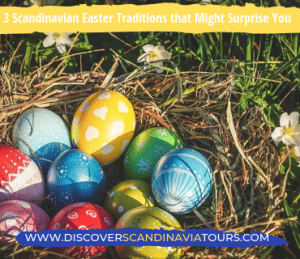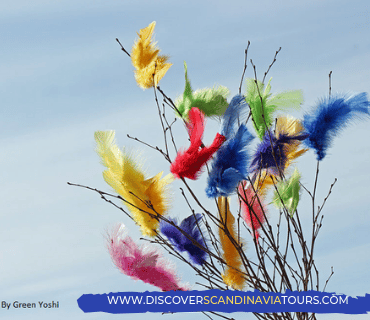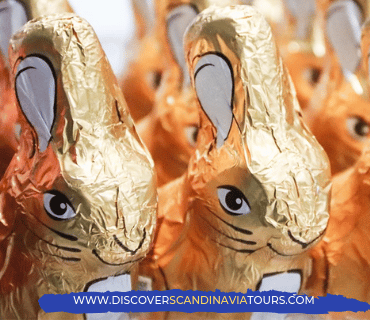by Veronica Lanzer & Marcelo Guimaraes

Easter – or Påsk in Swedish – is a fun time of the year. People are enjoying spring, kids are off school and families are getting together to celebrate. There are many Scandinavian Easter traditions, but we will focus on three of them here.
1. First Tradition: Påskris

This Swedish Easter tradition consists of putting colorful feathers and Easter ornaments in branches (usually birch branches). It is a way to decorate for Easter and to bring a piece of nature into our homes to celebrate spring. In fact, the very name Påskris is derived from the words for Easter and branch (or rod) in Swedish.
2. Second Tradition: Påskkärringar and Påskgubbar
According to this tradition, kids dress up for Easter as little witches and go around their neighborhood asking for treats, similarly to what is done during Halloween. This takes place on Maundy Thursday or the day before Easter, and the story is that they fly off to “blåkulla,” a made-up island that can only be reached by broomstick slights. This tradition is rooted in a rather dark chapter of Swedish history which took place in the 1600s, when a which hunt victimized many women.
In modern times the celebration is all about fun, with kids dressing up in long skirts and headscarves. They might also wear a black hat, black jacket, and mustache. Their faces are often painted with red cheeks and freckles and they look adorable. Kids go door to door and wish people happy Easter (Glad Påsk) and offer them an Easter drawing or painting. In return they get a piece of candy or a coin.
3. Third Tradition: Påskägg
Similarly to what is done in other parts of the world, most kids get one big Easter egg filled with candy or chocolate bunnies. The idea of plastic eggs with candy pieces inside (very popular in the United States) is not common in Sweden

Great food and cooking is a key part of holiday celebrations in Scandinavia and Easter is not an exception. Traditionally, a big Easter lunch or dinner is enjoyed with the entire family. You will often find herring, salmon and eggs at the Easter table, the first two being staples of the Scandinavian cuisine and reminders of their strong maritime roots.
Would you like to experience Easter in Sweden? Drop us a line and we will prepare an adventure just for you!